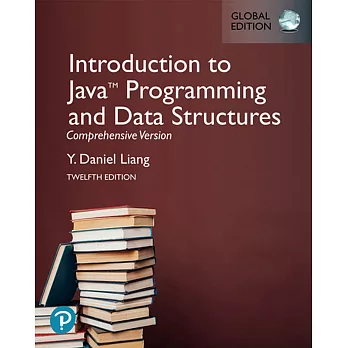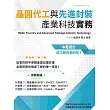本書為JAVA基本程式設計概念和技術的基礎介紹,將程式設計、資料結構和演算法整合到一本書中,本書採用「物件在後」的撰寫方式為讀者奠定基礎。作者以問題導向的方式介紹程式設計,重點是「解決問題」,而不是語法,且本書提供大量不同難度的習題以供練習。
-- --
A fundamentals-first introduction to basic programming concepts andtechniques
Introduction to Java Programming and Data Structures seamlessly integrates programming, data structures,and algorithms into one text. With a fundamentals-first approach, the textbuilds a strong foundation of basic programming concepts and techniques beforeteaching students object-oriented programming and advanced Java programming.Liang explains programming in a problem-driven way that focuses on problemsolving rather than syntax, illustrating basic concepts by example andproviding a large number of exercises with various levels of difficulty forstudents to practice. The 12th Edition is completely revised in everydetail to enhance clarity, presentation, content, examples, and exercises.
本書特色
Reach every student by pairing this text with MyLab Programming
MyLab™ is the teaching and learning platform that empowers you to reach every student. By combining trusted author content with digital tools and a flexible platform, MyLab personalizes the learning experience and improves results for each student.With MyLab Programming, students work through hundreds of short, auto-graded coding exercises and receive immediate and helpful feedback based on their work. Learn more about MyLab Programming.
- Provide students with the most relevant and current coding practices
* UPDATED - Java 9, 10, 11 and FX11 are covered to keep the text up-to-date with current technologies. Examples are improved and simplified.
* UPDATED - Lambda expressions are used in more examples and exercises in the data structures chapters to simplify coding.
* NEW - Both Comparable and Comparator are used to compare elements in Heap, Priority-Queue, BST, and AVLTree. This is consistent with the Java API, and is more useful and flexible.
* NEW - String matching algorithms are introduced in Chapter 22: Developing Efficient Algorithms.
- Help students understand the fundamentals of programming
* UPDATED - VideoNotes Tutorials provide step-by-step video tutorials specifically designed to enhance the programming concepts presented in the text.
* Check Points provide review questions to help students track their progress as they read through the chapter and evaluate their learning.
* The Chapter Summary reviews the important subjects that students should understand and remember. It helps them reinforce the key concepts they have learned in the chapter.
* Notes, Tips, Cautions, and Design Guides are inserted throughout the text to offer valuable advice and insight on important aspects of program development.
- Foster critical-thinking and problem-solving skills
* UPDATED - Programming Exercises are grouped by sections to provide students with opportunities to apply the new skills they have learned on their own. Additionally, more than 200 programming exercises with solutions, including several newly added exercises, are provided to the instructors on the Instructor Resource Website. These exercises are not printed in the text.
* Problems and Case Studies teach problem-solving and programming concepts. The book uses many small, simple, and stimulating examples to demonstrate important ideas.
* Quizzes are accessible online, grouped by sections, for students to self-test on programming concepts and techniques.
- Reach every student with MyLab
- Teach your course your way: Your course is unique. So whether you’d like to build your own assignments, teach multiple sections, or set prerequisites, MyLab gives you the flexibility to easily create your course to fit your needs.
* The Exercise Editor now allows you to create new programming exercises. In addition to assigning the hundreds of programming exercises already available, you can create and assign programming exercises to customize your course.
* Plagiarism Detection Tool alerts instructors of potential plagiarism issues by checking:
-Students’ average submission rate.
-Students’ average number of attempts until correct.
- Empower each learner: Each student learns at a different pace. Personalized learning pinpoints the precise areas where each student needs practice, giving all students the support they need — when and where they need it — to be successful.
* Interactive Practice provides first-hand programming experience in an interactive online environment.
* The error-specific messages include both the feedback from the compiler and plain English interpretations of likely causes for the student’s incorrect answer. Feedback for many exercises includes test case tables that show a student’s output against expected output.
* Pearson eText is a simple-to-use, personalized reading experience available within MyLab. Students can use their computer or the mobile app to easily highlight and take notes all in one place — even when offline. Seamlessly integrated videos and rich media* give students access to the help they need, when they need it. You can also share your own notes with students so they see the connection between their reading and what they learn in class.
- Deliver trusted content: You deserve teaching materials that meet your own high standards for your course. That’s why we partner with highly respected authors to develop interactive content and course-specific resources that you can trust — and that keep your students engaged.
* VideoNotes provide step-by-step video tutorials specifically designed to enhance the programming concepts so students can view the entire problem-solving process outside of the classroom–when they need help the most.
* Algorithm Animations demonstrate how algorithms work.
* Hundreds of short, auto-graded coding exercises are mapped to Introduction to Java Programming and Data Structures. For students, the system automatically detects errors in the logic and syntax of their code submissions and offers targeted hints that enable students to figure out what went wrong—and why. The exercises help students master programming fundamentals (syntax, flow of control), allowing instructors to focus on higher-level concepts (problem solving).
- Improve student results: When you teach with MyLab, student performance often improves. That’s why instructors have chosen MyLab for over 15 years, touching the lives of over 50 million students.
New to This Edition
- Provide students with the most relevant and current coding practices
* Java 9, 10, 11 and FX11 are covered to keep the text up-to-date with current technologies. Examples are improved and simplified.
* Lambda expressions are used in more examples and exercises in the data structures chapters to simplify coding.
* Both Comparable and Comparator are used to compare elements in Heap, Priority-Queue, BST, and AVLTree. This is consistent with the Java API, and is more useful and flexible.
* String matching algorithms are introduced in Chapter 22: Developing Efficient Algorithms.
- Help students understand the fundamentals of programming
* VideoNotes Tutorials provide step-by-step video tutorials specifically designed to enhance the programming concepts presented in the text.
- Foster critical-thinking and problem-solving skills
* Programming Exercises are grouped by sections to provide students with opportunities to apply the new skills they have learned on their own. Additionally, more than 200 programming exercises with solutions, including several newly added exercises, are provided to the instructors on the Instructor Resource Website. These exercises are not printed in the text.



 天天爆殺
天天爆殺  今日66折
今日66折 





















![威廉.肯特里奇[精裝]](https://im1.book.com.tw/image/getImage?i=https://www.books.com.tw/img/001/098/79/0010987920.jpg&v=66263c53k&w=110&h=110)


 博客來
博客來 博客來
博客來 博客來
博客來 博客來
博客來 博客來
博客來